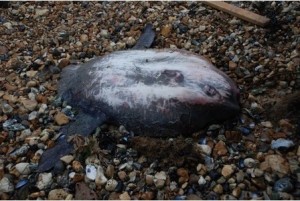Aquatic scientific names in the news …
An Ocean sunfish was found on New Year’s Day 2016 washed up on Whitstable beach (Canterbury Times 4th Jan). A subtropical species with a global distribution, they are by no means rare in British waters but are most often encountered around the southern and western coasts of the British Isles during the summer months.
At a reported length of 80cm it would seem to be a young specimen given that the average size of an adult Mola mola is 1.8 m from the tip of the snout to the end of the tail fin. Famously the heaviest of all the bony fishes with an average weight of around 1 tonne and a maximum recorded weight of around 2.3 tonnes.
Mola mola (Linnaeus, 1758), the Ocean sunfish
Etymology.
Mola – Latin, mill, millstone; grinders, molar-teeth. Alluding to the fact that the fish is similar in shape to a millstone (G. Rondelet De Piscibus Marinis1554).
This scientific name is an example of a tautonym, that is where both the genus and species name are the same; permissible for zoological nomenclature but not allowable under the rules governing botanical names. The reason for this double naming is not clear, in keeping with the etymology of the word mola it may be a reference to its thick rough skin or possibly to its dentition with its teeth fused to form a parrot-like beak.
